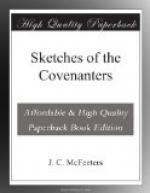A third time the cavalry charged up the hill, and a third time the Covenanters hurled them back. Dalziel at last moved his entire force forward, which, like a tidal wave, carried all before it. The Covenanters were swept from the field leaving 50 dead. The battle was lost, but not the cause. These heroes fought well. The defeat was certain, in their own minds, even before a shot was fired; but believing that the cause of liberty now demanded a sacrifice, they freely offered up themselves on the altar.
Rullion Green! How euphonic the name! What music in the words! What clustering memories to awaken all that is heroic and ennobling in our hearts! De we appreciate the fruits of the fields, fertilized with the blood of the fathers? Are we loyal as they were to the Covenants? Do our lives arise into the heroic spirit, and take on the moral grandeur exhibited by them?
* * * * *
Points for the class.
1. What led to the battle of Rullion Green?
2. Who commanded on each side?
3. What was the respective strength of the forces?
4. Where was the engagement fought?
5. Describe the battle. How did it issue?
6. For what were the Covenanters contending?
7. What fruits of their sufferings do we now enjoy?
XXX.
The oppressor’s revenge.—A.D. 1667.
The sun was sinking behind the Pentland hills, when the last assault was made upon the Covenanters at the battle of Rullion Green. They, being driven from the field, were pursued without mercy till night kindly threw its shadow over the scene of carnage. About 30 were slaughtered in the flight, and 50 taken prisoners; many of these were speedily executed.
The stars timidly arose and shed their pale light over the crimsoned field. The night was bitterly cold. The dead lay scattered over the frosted ground, and the air was burdened with the groans of the dying. All had been barbarously stripped of their clothing by the ruthless conquerors. The blood of the dying was chilled in their veins, ere it oozed from their wounds and froze upon the ground. The tender-hearted women of Edinburgh came the next day, with clothes for the living and winding sheets for the dead. An upright stone, two feet by three, marks the place where these soldiers of Christ, in number about 50, calmly sleep, awaiting the resurrection of the just. Beautiful fir trees swaying their soft branches over the grave seem to be singing the dirge of the fallen heroes.
Heroes! This was a forlorn battle. The battle that must be lost, that other battles may be won, demands heroes of the noblest type; and here were the men. They were willing to fight in the presence of defeat. Listen to their resolution just before the battle: “We will follow on, till God shall do His service by us; and though we should all die at the end of it, we think the giving of a testimony enough for all.”




